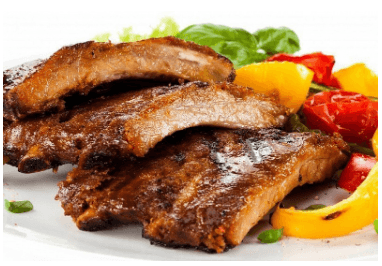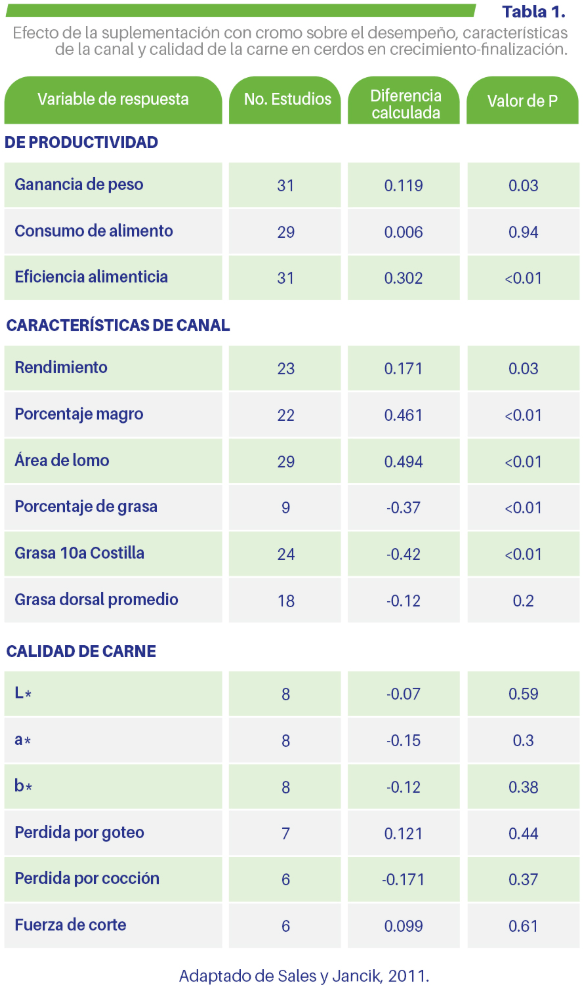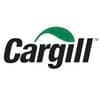Reconsideración del Cromo como nutraceútico en cerdos, Nuevas regulaciones


1.- Giri J, Usha K, Sunitha T. Evaluation of the selenium and chromium content of plant foods. Plant Foods Hum. Nutr. 1990; 40:49.
2.- Shroeder H A. Losses of vitamins and trace minerals resulting from processing and preservation of foods. Am. J. Coo. Nutr. 1971; 24:562.
3.- Pond WG, Houpt KA. The biology of the pig. Cornell, NY: Cornell University Press; 1978.
4.- Anderson DM, Elsley FWH. The intravenous glucose tolerance test in the pig. Q J Exper Physiol 1970; 55:104.
5.- George PB, England DC, Siers DG, Stanton HC. Diabetogenic effects of pregnancy in sows on plasma glucose and insulin release. J Anim Sci 1978;46:1695.
6.- National Research Council. Nutrient requirements of swine. 9th ed. Washington, DC; National Academy Press; 1988.
7.- Steele N C, Althen T G, Frobish L T. Biological activity of glucose tolerance factor in swine. J. Anim. Sci. 1977;45; 1341.
8.- Physiol Behav. 2014 Jun 22;133:197-206. Insulin: its role in the central control of reproduction.
Sliwowska JH, Fergani C, Gawalek M, Skowronska B, Fichna P, Lehman MN.
9.- Evock-Clover CM, Polansky MM, Anderson RA, Steele NC. Dietary chromium supplementation with or without somatotropin treatment alters serum hormones and metabolites in growing pigs without affecting growth performance. J Nutr 1993; 123:1504.
10.- Page T G, Southern L L, ward T L, Thompson D L. Effect of chromium picolinate on growth and serum and carcass traits of growing-finishing pigs. J. Anim. Sci. 1993; 71:656.
11.- Kutsky R J. Handbook of vitamins, minerals and hormones. 2" Ed. Estados Unidos de Norteamerica: Van Nostrand Reinhold Company, 1981:113
12.- Evans G W, Johnson E C. Zinc absorption in rats fed a low-protein diet supplemented with tryptophan or picoliDic acid. J. Nutr. 1980; 110:1076.
13.- Aggett JP, Fenwick K P, Kirk H. An in vitro study of the effect picolinic acid on metal translocation across lipid biIayers. J. Nutr. 1989; 119:1432.
14.- N.R.C. Mineral Tolerance of Domestic Animals: «Chromium., National Academy Press. washington D.C., Estados Unidos de Norteamerica, 1980;142.
15.- Seal C J, Heaton F W. Effect of dietary Picolinic acid on the metabolism ofexogenous and endogenous zinc in the rat. J. Nutr. 1985; 115:986.
16.- Lindemann MD, Wood CM, Harper AF, Kornegay ET, Anderson RA (1995) Dietary chromium picolinate additions improve gain: feed, and carcass characteristics in growing-finishing pigs and increase litter size in reproducing sows. J Anim Sci 73:457–465.
17.- Kemp B, Soede NM, Vesseur PC, Helmond FA, Spoorenberg JH, Frankena K. Glucose tolerance of pregnant sows is related to postnatal piglet mortality. J Anim Sci 1996; 74:879.
18.- Britt JH, Armstrong JD, Cox. Metabolic interfaces between nutrition and reproduction. Proceedings 11 th International Congress Animal Reproduction Artificial insemination. Dublin Ireland; 1988. P 117-125.
19.- Cox NM, Stuart MJ, Althen TG, Bennett, Miller H. Enhancement of ovulation rate in gilts by increasing dietary energy and administering insulin during follicular growth. J Anim Sci 1987; 64:507.
20.- Garcia Mr, Newcomb MD, Trout WE. Effects of dietary chromium picolinate supplementation on glucose tolerance and ovarian and uterine function in glits. J Anim Sci. 1997ñ75:82
21.- Kornegay ET, Wang Z, Wood CM, Lindemann MD. Supplemental chromium picolinate influences nitrogen balance, dry matter digestibility and carcass traits in growing-finishing pigs. J Anim Sci 1997;75:1319.
22.- Lindermann MD. Chromium picolinate for the enhancement of muscle development and nutrient management. Nutrient management of food animals to enhance and protect the environment. Boc Raton, Fl. CRS Press; 1996. P 303-3124.
23.- Evans GW, Bowman TD. Chromiumpicolinate increases membrane fluidity and rate of insulin internalization. J Onorg Biochem. 1996;35:12963-12969.
24.- Sales and Jancik, Effects of dietary chromium supplementation on performance, carcass characteristics, and meat quality of growing-finishing swine: A meta-analysis. J. Anim. Sci.2011










